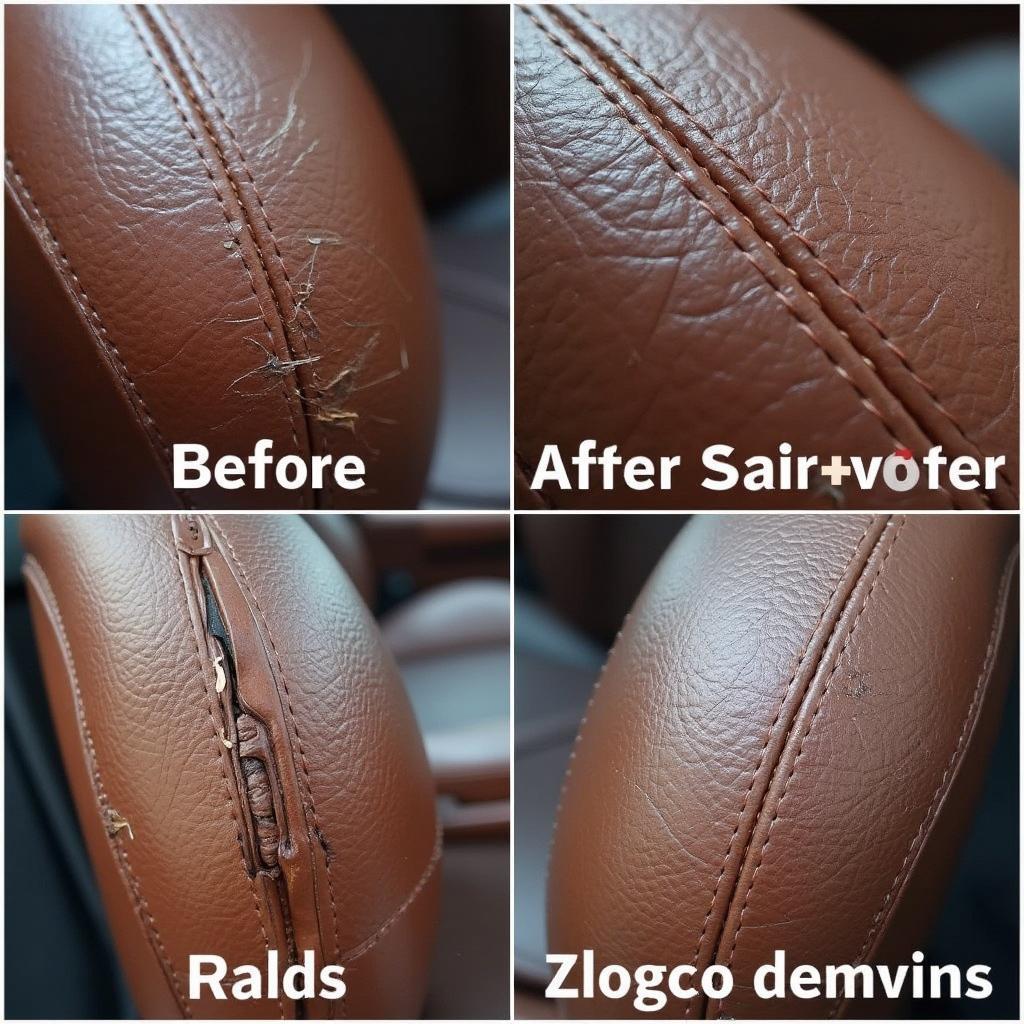Leather car seats are a luxurious addition to any vehicle, but they require proper care and maintenance to stay looking their best. Over time, leather can become faded, cracked, and stained, detracting from the overall appearance of your car’s interior. Fortunately, with a little effort and the right techniques, you can often repair these issues yourself and restore your leather seats to their former glory.
Identifying Common Leather Seat Damage
Before diving into the repair process, it’s crucial to identify the type of damage your leather seats have sustained. This will help you determine the appropriate repair methods and products to use.
Common types of leather car seat damage include:
- Cracks: These are thin, linear breaks in the leather’s surface, often caused by dryness, UV exposure, and general wear and tear.
- Scratches: Superficial abrasions on the leather’s surface can occur from sharp objects, pet claws, or even friction from clothing.
- Tears: More severe than scratches, tears involve a complete separation of the leather material.
- Fading: Prolonged exposure to sunlight can cause the leather’s color to fade and lose its vibrancy.
- Stains: Spills from food, drinks, or other substances can leave unsightly marks on leather seats.
 Types of Leather Car Seat Damage
Types of Leather Car Seat Damage
Essential Tools and Materials for Leather Car Seat Repair
Having the right tools and materials on hand will make the repair process smoother and more effective. Here are some essentials:
- Leather Cleaning Solution: Use a dedicated leather cleaner to remove dirt, grime, and debris before starting any repairs. Avoid harsh household cleaners, as they can damage the leather.
- Leather Conditioner: This helps replenish moisture and keep the leather supple, preventing future cracking and damage.
- Leather Repair Kit: These kits typically contain a color-matched filler compound, adhesive, applicators, and a grain paper for replicating the leather’s texture. Choose a kit that matches your leather’s color and grain as closely as possible.
- Microfiber Cloths: Soft, lint-free microfiber cloths are ideal for applying cleaning solutions, conditioners, and repair compounds.
- Rubbing Alcohol: Useful for cleaning the damaged area and ensuring proper adhesion of repair materials.
- Heat Gun or Hair Dryer: Applying gentle heat can help the repair compound cure and blend more effectively.
- Scissors and Utility Knife: For trimming excess repair material and preparing damaged areas.
- Masking Tape: Protects surrounding areas from accidental contact with repair compounds.
Step-by-Step Guide to Repairing Cracked Leather Car Seats
Cracked leather is a common problem that, if left untreated, can worsen over time. Here’s how to repair cracked leather car seats effectively:
- Clean the Area: Start by thoroughly cleaning the cracked area with a leather cleaner and a microfiber cloth. Remove all dirt, grime, and residue.
- Prepare the Cracks: Use a fine-grit sandpaper (around 600-grit) to gently sand down any raised edges or loose leather around the cracks. Be careful not to overdo it and damage the surrounding leather.
- Apply the Leather Filler: If the cracks are deep, apply a leather filler compound to fill in the gaps. Use a palette knife or the applicator provided in your repair kit. Overfill the cracks slightly to allow for shrinkage during drying.
- Match the Texture: If your leather has a noticeable grain pattern, use the grain paper provided in your repair kit to imprint the pattern onto the filler compound while it’s still wet.
- Level and Blend: Carefully remove any excess filler compound with a palette knife, ensuring a smooth and even surface. Use a damp microfiber cloth to blend the edges of the filler with the surrounding leather.
- Apply Leather Dye (If Needed): If the color of the repaired area doesn’t perfectly match the rest of the seat, you can apply a leather dye to blend it in. Test the dye on an inconspicuous area first to ensure color accuracy.
- Heat Set the Repair: Once the filler and dye are dry, use a heat gun or hair dryer on a low setting to gently heat the repaired area. This helps the repair materials cure and bond more effectively with the leather.
- Condition the Leather: After the repair is complete, apply a high-quality leather conditioner to the entire seat to moisturize and protect the leather. This will help prevent future cracking and keep your seats looking their best.
Tips for Maintaining Leather Car Seats
Prevention is key to keeping your leather car seats in top condition. Here are some expert tips:
- Regular Cleaning: Clean your leather seats regularly (every 4-6 weeks) with a dedicated leather cleaner and a microfiber cloth.
- Conditioning is Crucial: Apply a leather conditioner after each cleaning and at least every three months to keep the leather hydrated and prevent drying and cracking.
- Avoid Direct Sunlight: Prolonged exposure to UV rays can fade and damage leather. Park in the shade whenever possible or use a sunshade to protect your car’s interior.
- Address Spills Promptly: Quickly blot up spills with a clean cloth to prevent staining. Avoid rubbing, as this can spread the stain and damage the leather.
- Professional Detailing: Consider having your leather seats professionally cleaned and conditioned once or twice a year for optimal care.
Frequently Asked Questions About Leather Car Seat Repair
Q: Can I use superglue to repair a tear in my leather car seat?
A: It’s not recommended to use superglue or other strong adhesives on leather car seats. These adhesives can create a rigid bond that can crack and deteriorate over time, leading to further damage. Opt for a flexible leather adhesive or a repair kit specifically designed for leather.
Q: How can I remove pen marks from my leather car seats?
A: For fresh pen marks, try gently blotting the area with a microfiber cloth dampened with rubbing alcohol. For stubborn stains, consider using a dedicated leather stain remover.
“Always test any cleaning product or repair method on an inconspicuous area first to ensure it doesn’t damage or discolor your leather,” advises Sarah Johnson, a veteran automotive detailer with over 15 years of experience. “Leather can be quite delicate, so it’s always better to err on the side of caution.”
Conclusion
Repairing your own leather car seats can be a rewarding and cost-effective way to restore your vehicle’s interior. By following these tips and techniques, you can address common leather damage and keep your seats looking their best for years to come. Remember, regular maintenance is crucial for preventing future damage and ensuring the longevity of your leather car seats.
Need assistance with your leather car seat repair? Don’t hesitate to contact us via WhatsApp: +1(641)206-8880, or Email: [email protected]. Our dedicated customer support team is available 24/7 to assist you.

